The Palace of Versailles (original) (raw)
| | Western Europe | | | |
| ---------------------------------------------------------------------------------------------------------------------------------------------------------------------------------------------------------------------------------------------------------------------------------------------------------------------------------------------------------------------------------------------------------------------------------------------------------------------------------------------------------------------------------------------------------------------------------------------------------------------------------------------------------------------------------------------------------------------------------------------------------------------------------------------------------------------------------------------------------------------------------------------------------------------------------------------------------------------------------------------------------------------------------------------------------------------------------------------------------------------------------------------------------------------------------------------------------------------------------------------------------------------------------------------------------------------------------------------------------------------------------------------------------------------------------------------------------------------------------------------------------------------------------------------------------------------------------------------------------------------------------------------------------------------------------------------------------------------------------------------------------------------------------------------------------------------------------------------------------------------------------------------------------------------------------------------------------------------------------------------------------------------------------------------------------------------------------------------------------------------------------------------------------------------------------------------------------------------------------------------------------------------------------------------------------------------------------------------------------------------------------------------------------------------------------------------------------------------------------------------------------------------------------------------------------------------------------------------------------------------------------------------------------------------------------------------------------------------------------------------------------------------------------------------------------------------------------------------------------------------------------------------------------------------------------------------------------------------------------------------------------------------------------------------------------------------------------------------------------------------------------------------------------------------------------------------------------------------------------------------------------------------------------------- | | ------------------------------------------------------------------------------------------------------------------------------------------------------------------------------------------------------------------------------------------------------------------------------------------------------------------------------------------------------------------------------------------------------------------------------------------------------------------------------------------------------------------------------------------------------------------------------------------------------------------------------------------------------------------------------------------------------------------------------------------------------------------------------------------------------------------------------------------------------------------------------------------------------------------------------------------------------------------------------------------------------------------------------------------------- | |
| | It was in 1623 that King Louis XIII of France had a hunting lodge built at Versailles-au-Val-de-Galie. The Galie Valley was a wild marshy woodland, with a small village situated alongside it, but it was rich in game and not far from the royal residence of Saint-Germain-en-Laye. Versailles was first mentioned in 1142, in the Charter of the Abbey of Saint-Père de Chartres. One of the signatories to that charter was Hugo Versailles, so in usual medieval manorial practice his name was appended to the village which existed on the manor's lands. The village, with a church and a small castle, was mildly prosperous until a resurgence of plague swept through it in the fifteenth century. It emerged heavily depopulated and a mere shadow of its former self. In 1575, the Florentine Archbishop Jean-François de Gondi purchased the manor and all its belongings. Carrying some influence at court, the archbishop invited the king on several hunting trips to his forests around Versailles. Louis XIII found himself to be satisfied with what he saw, so he decided to purchase the land from the archbishop. The hunting lodge, or pavilion, he ordered to be built there in 1624 was a relatively simple structure of brick, stone, and slate. Louis XIII spent his first night in his new lodge on 8 March 1624. After that he started spending more and more time there, not only for the fine hunting, but to escape from state duties and the royal court, and from the queen, Anne of Austria. He made it quite clear that she was not welcome at Versailles, so her two visits there proved to be her only visits. The lodge was so much to the king's liking that in 1631 he had his architect (and royal engineer), Philibert Le Roy, extend the building. The pavilion was enlarged and wings were added to each side to form the Marble Court which survives at the heart of the structure today. The first, small, formal gardens were added alongside a moat and four pavilions. The chateau, however, remained a maison de plaisance, or country cottage. The 'Sun King' Louis XIII died in 1643, and the country was governed by Cardinal Mazarin's regency until the king's young son was twenty-three. Straight away, in 1661, Louis XIV ordered his own architect, Louis Le Vau, to embellish the chateau at Versailles in a project which took seven years to achieve. Le Vau (1612-1683) was a Parisian French Classical architect who, during the course of his career, was responsible for work on several notable buildings, including the Palace of the Louvre. 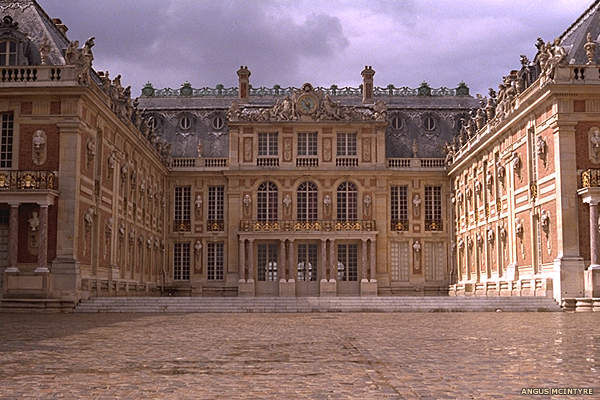 The Marble Court at the heart of the palace was formed out of the earlier pavilion, part of the original lodge of 1624 | | FOLLOWING PAGES: Photo Focus: Around Versailles Napoleon's Last Resting Place Remains Found in Belarus McDonalds of the French Empire RULERS OF EUROPE: Kings of France Holy Roman Emperors Kings of Poland EXTERNAL LINKS: Chateau Versailles Great Buildings Collection The Palace of Versailles (dead link) Paris Photos
The Marble Court at the heart of the palace was formed out of the earlier pavilion, part of the original lodge of 1624 | | FOLLOWING PAGES: Photo Focus: Around Versailles Napoleon's Last Resting Place Remains Found in Belarus McDonalds of the French Empire RULERS OF EUROPE: Kings of France Holy Roman Emperors Kings of Poland EXTERNAL LINKS: Chateau Versailles Great Buildings Collection The Palace of Versailles (dead link) Paris Photos 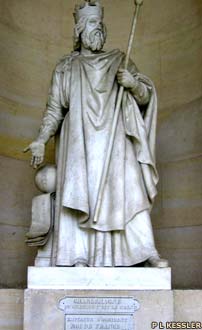 Charlemagne, or Charles I 'the Great', emperor of the west and king of France | |
| | However, even this version of the chateau was deemed too small and more work was planned. In the meantime, and in a response to increasing European awareness and interest in zoology and exotic creatures, Louis ordered the construction of the menagerie in 1662 or 1663. Completed two years later, again by Le Vau, it was located at one end of the Grand Canal. The set of buildings featured an octagonal two-story pavilion its centre, but although animals were first introduced in 1664, the interior fixtures and fittings were not completed until 1670. Despite that, the fact that it was Louis' menagerie made it an instantly fashionable destination for visitors and courtiers. Governors in French colonies and the Compagnie des Indes Orientales (French East India Company) had a standing order for rare species, and an animal purveyor was sent to the Levant each year. Less mighty rulers also thought it prudent to send wild animals to the 'Sun King' as tribute. | | | |
| | The menagerie was followed by the creation of the orangery (1663) and the Thetis Grotto (built on the North Lawn in 1664-1666). Considered to be one of the finest single pieces of architecture in Versailles, the orangery was dug into the slope below the chateau and was flanked by the Great One Hundred Step Staircases. Double glazing and its sheltered position helped maintain a temperature of between 5�C and 8�C all year round. As the finishing touches were made to the menagerie, Le Vau was entrusted with the main project to extend the palace. The concept was to envelop the old chateau inside a new and more grand one. The east front was to remain as it was and new construction would be built around it on the other three sides. This plan became known as the Envelope Design. By 1671, the basic structural work had been completed. The envelope was a set of structural elements in the shape of a 'U' around the Old Chateau on the three garden sides, thereby forming two symmetrical enclosed courts. Between 1668-1670 Le Vau constructed this 'envelope' of uniformly white stone façades which wrapped around the older buildings and was contemporarily known as the New Chateau. The buildings were inspired by Italian Baroque architecture, and these provided the royal family with lodgings, the State Apartments, and a large terrace on the western section which overlooked the gardens. During this phase of the building work, the Marble Court, the original entrance to the old hunting lodge, received the paving which gave it its name. But when Le Vau died in 1670, his assistant François d'Orbay (died 1697) was assigned as his replacement. Decorator Charles Le Brun (1619-1690) was entrusted with handling the decoration of the completed interior structure. A Parisian by birth, he was declared by Louis XIV to be the most important painter of seventeenth century France. With a long list of major works under his belt, including the council apartments in the Palace of the Louvre, Le Brun was able to realise the king's grandiose dreams for Versailles which surpassed not only the imagination but also his budget. For his pains, Le Brun was named by the king as 'Premier (first) Painter'. More work was undertaken in the palace's third building campaign between 1679-1684, part of which included destroying the new chateau's terrace which overlooked the gardens, transforming it into the enclosed Hall of Mirrors which was intended to symbolise the power of Louis XIV's absolute monarchy. The royal architect, Jules Hardouin-Mansart, was given the task of directing the work. Born in Paris in 1646, Jules Hardouin trained under his architect great-uncle, Francois Mansart, and inherited an enormous collection of plans and drawings which he utilised in his later work. He also added his great-uncle's name to his own and is generally considered to be one of the most important French Baroque architects in Europe in the seventeenth century. His work generated architecture which epitomised the grand era of the 'Sun King'. He was also the creator of the 'Mansard roof' which proved popular in American architecture, especially during the Victorian era. | |
Charlemagne, or Charles I 'the Great', emperor of the west and king of France | |
| | However, even this version of the chateau was deemed too small and more work was planned. In the meantime, and in a response to increasing European awareness and interest in zoology and exotic creatures, Louis ordered the construction of the menagerie in 1662 or 1663. Completed two years later, again by Le Vau, it was located at one end of the Grand Canal. The set of buildings featured an octagonal two-story pavilion its centre, but although animals were first introduced in 1664, the interior fixtures and fittings were not completed until 1670. Despite that, the fact that it was Louis' menagerie made it an instantly fashionable destination for visitors and courtiers. Governors in French colonies and the Compagnie des Indes Orientales (French East India Company) had a standing order for rare species, and an animal purveyor was sent to the Levant each year. Less mighty rulers also thought it prudent to send wild animals to the 'Sun King' as tribute. | | | |
| | The menagerie was followed by the creation of the orangery (1663) and the Thetis Grotto (built on the North Lawn in 1664-1666). Considered to be one of the finest single pieces of architecture in Versailles, the orangery was dug into the slope below the chateau and was flanked by the Great One Hundred Step Staircases. Double glazing and its sheltered position helped maintain a temperature of between 5�C and 8�C all year round. As the finishing touches were made to the menagerie, Le Vau was entrusted with the main project to extend the palace. The concept was to envelop the old chateau inside a new and more grand one. The east front was to remain as it was and new construction would be built around it on the other three sides. This plan became known as the Envelope Design. By 1671, the basic structural work had been completed. The envelope was a set of structural elements in the shape of a 'U' around the Old Chateau on the three garden sides, thereby forming two symmetrical enclosed courts. Between 1668-1670 Le Vau constructed this 'envelope' of uniformly white stone façades which wrapped around the older buildings and was contemporarily known as the New Chateau. The buildings were inspired by Italian Baroque architecture, and these provided the royal family with lodgings, the State Apartments, and a large terrace on the western section which overlooked the gardens. During this phase of the building work, the Marble Court, the original entrance to the old hunting lodge, received the paving which gave it its name. But when Le Vau died in 1670, his assistant François d'Orbay (died 1697) was assigned as his replacement. Decorator Charles Le Brun (1619-1690) was entrusted with handling the decoration of the completed interior structure. A Parisian by birth, he was declared by Louis XIV to be the most important painter of seventeenth century France. With a long list of major works under his belt, including the council apartments in the Palace of the Louvre, Le Brun was able to realise the king's grandiose dreams for Versailles which surpassed not only the imagination but also his budget. For his pains, Le Brun was named by the king as 'Premier (first) Painter'. More work was undertaken in the palace's third building campaign between 1679-1684, part of which included destroying the new chateau's terrace which overlooked the gardens, transforming it into the enclosed Hall of Mirrors which was intended to symbolise the power of Louis XIV's absolute monarchy. The royal architect, Jules Hardouin-Mansart, was given the task of directing the work. Born in Paris in 1646, Jules Hardouin trained under his architect great-uncle, Francois Mansart, and inherited an enormous collection of plans and drawings which he utilised in his later work. He also added his great-uncle's name to his own and is generally considered to be one of the most important French Baroque architects in Europe in the seventeenth century. His work generated architecture which epitomised the grand era of the 'Sun King'. He was also the creator of the 'Mansard roof' which proved popular in American architecture, especially during the Victorian era. | | 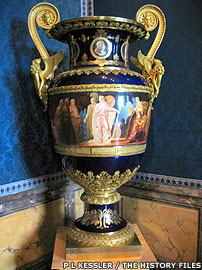 Louis XIV is depicted in this highly ornate vase, shown centre and 'glowing' | |
| | The Grand Stables were built at this time (1680-1681), so named because they were the domain of the grand equerry. This individual was responsible for the horses which were highly trained for hunting or warfare and were to be ridden by royalty only. Finally, the Grand Lodgings were completed, housing kitchens and tables for officers who served the royal family and holding 600 rooms for courtiers. Landscape architect André Le Nôtre (1613-1700), who came from a family of royal gardeners, managed a detailed renovation of the palace's gardens at the same time. Charles Le Brun collaborated with Le Nôtre in landscaping the gardens, but he was again responsible for interior decoration. One of his finest efforts involved adding the final decor to the suite of rooms which formed the 'King's State Apartment' between 1671-1681. The rooms were dedicated to the planets gravitating around Apollo, the god in Greek and Roman mythology who symbolised the sun, Louis' emblem. The king's new home was now fit for purpose. On 6 May 1682 Louis XIV left the palace of the Louvre in the heart of Paris and moved to Versailles. The palace became the official residence of the French royal court and the de facto capital of France. It would remain so until the French Revolution. With the king now resident at Versailles, the final stages of the work carried on at a rapid pace, with completion following in 1684. The king used his new State Apartment exclusively for audiences and court entertainment since he himself lived in rooms which overlooked the old Marble Court. From what had been a huge construction site, Mansart had overseen the raising of the north and south wings of the chateau (1687-1688). Louis XIV's grandson, Louis, duke of Burgundy, was married in 1697, to the twelve year-old Marie-Adelaide of Savoy. The young duchess was a very vivacious and precocious addition to the royal court, quickly gaining the favour of the aging king. As a sign of his favour he presented the menagerie to her, and the interior of the building was redecorated between 1698-1700. The style used was a departure from the usual courtly austerity, instead anticipating the Rococo style which would be popular in the eighteenth century. The almost-completed palace now contained 2,143 windows, 1,252 fireplaces, and 67 staircases. Le Nôtre's gardens included roughly 1,400 fountains using a water system which pumped water from the Seine through almost 160km of pipework. The length of the garden frontage was 670 metres. Due to the fact that it was built up in several stages and over a span of nearly half a century, the layout was rather sprawling. | | EXTERNAL LINKS: Charles Le Brun Sculptures of Versailles (in French)
Louis XIV is depicted in this highly ornate vase, shown centre and 'glowing' | |
| | The Grand Stables were built at this time (1680-1681), so named because they were the domain of the grand equerry. This individual was responsible for the horses which were highly trained for hunting or warfare and were to be ridden by royalty only. Finally, the Grand Lodgings were completed, housing kitchens and tables for officers who served the royal family and holding 600 rooms for courtiers. Landscape architect André Le Nôtre (1613-1700), who came from a family of royal gardeners, managed a detailed renovation of the palace's gardens at the same time. Charles Le Brun collaborated with Le Nôtre in landscaping the gardens, but he was again responsible for interior decoration. One of his finest efforts involved adding the final decor to the suite of rooms which formed the 'King's State Apartment' between 1671-1681. The rooms were dedicated to the planets gravitating around Apollo, the god in Greek and Roman mythology who symbolised the sun, Louis' emblem. The king's new home was now fit for purpose. On 6 May 1682 Louis XIV left the palace of the Louvre in the heart of Paris and moved to Versailles. The palace became the official residence of the French royal court and the de facto capital of France. It would remain so until the French Revolution. With the king now resident at Versailles, the final stages of the work carried on at a rapid pace, with completion following in 1684. The king used his new State Apartment exclusively for audiences and court entertainment since he himself lived in rooms which overlooked the old Marble Court. From what had been a huge construction site, Mansart had overseen the raising of the north and south wings of the chateau (1687-1688). Louis XIV's grandson, Louis, duke of Burgundy, was married in 1697, to the twelve year-old Marie-Adelaide of Savoy. The young duchess was a very vivacious and precocious addition to the royal court, quickly gaining the favour of the aging king. As a sign of his favour he presented the menagerie to her, and the interior of the building was redecorated between 1698-1700. The style used was a departure from the usual courtly austerity, instead anticipating the Rococo style which would be popular in the eighteenth century. The almost-completed palace now contained 2,143 windows, 1,252 fireplaces, and 67 staircases. Le Nôtre's gardens included roughly 1,400 fountains using a water system which pumped water from the Seine through almost 160km of pipework. The length of the garden frontage was 670 metres. Due to the fact that it was built up in several stages and over a span of nearly half a century, the layout was rather sprawling. | | EXTERNAL LINKS: Charles Le Brun Sculptures of Versailles (in French) 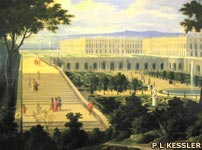 A painting at Versailles shows an idealised view of its parks and gardens | |
| | The Trianon Within those sprawling gardens the Grand Trianon was a focal point. It could be reached by boat sailing along the Grand Canal, and it replaced a 'pavilion d'agrément' which had been used as a spot at which to take refreshment. This had been built by Louis Le Vau in 1669-1670, and was redecorated in 1672-1674 by a collection of experts. As it was covered in blue and white porcelain, its name of the Porcelain Trianon was ideal. Unfortunately its lifetime was a short one. It was prone to cold weather damage and Louis so liked the spot that he commissioned the building of the Grand Trianon there. The Grand Trianon was erected in 1687-1689 by Mansart, replacing the Porcelain Trianon, in order to provide Louis with the retreat he wanted at the far end of the park. Despite having sealed himself off from most of society at Versailles, the king felt he needed a way of escaping the crowd of courtiers and the constraints of power. The building consisted of two wings joined together at the far end by a peristyle which was adorned with columns and tiled flooring through which visitors could catch a glimpse of the ornamental and flower gardens beyond. It would have been (and very much remains) the perfect place to stand during summer showers. The building followed the Italianate school of style and consisted merely of a ground floor which was covered by a flat roof (hidden by a balustrade). Pink Languedoc marble pilasters punctuated the façades. Louis was particularly fond of the Trianon (as it was originally known). He would visit for short stays in the summer along with his family, and occupy three apartments in turn, one on the right wing (1688-1691), another in the left wing (1691-1703), and then he returned to the right wing (1703-1715). Elsewhere, in the fourth construction campaign of 1699-1703, redecorating work and decorative additions were added to the menagerie.
A painting at Versailles shows an idealised view of its parks and gardens | |
| | The Trianon Within those sprawling gardens the Grand Trianon was a focal point. It could be reached by boat sailing along the Grand Canal, and it replaced a 'pavilion d'agrément' which had been used as a spot at which to take refreshment. This had been built by Louis Le Vau in 1669-1670, and was redecorated in 1672-1674 by a collection of experts. As it was covered in blue and white porcelain, its name of the Porcelain Trianon was ideal. Unfortunately its lifetime was a short one. It was prone to cold weather damage and Louis so liked the spot that he commissioned the building of the Grand Trianon there. The Grand Trianon was erected in 1687-1689 by Mansart, replacing the Porcelain Trianon, in order to provide Louis with the retreat he wanted at the far end of the park. Despite having sealed himself off from most of society at Versailles, the king felt he needed a way of escaping the crowd of courtiers and the constraints of power. The building consisted of two wings joined together at the far end by a peristyle which was adorned with columns and tiled flooring through which visitors could catch a glimpse of the ornamental and flower gardens beyond. It would have been (and very much remains) the perfect place to stand during summer showers. The building followed the Italianate school of style and consisted merely of a ground floor which was covered by a flat roof (hidden by a balustrade). Pink Languedoc marble pilasters punctuated the façades. Louis was particularly fond of the Trianon (as it was originally known). He would visit for short stays in the summer along with his family, and occupy three apartments in turn, one on the right wing (1688-1691), another in the left wing (1691-1703), and then he returned to the right wing (1703-1715). Elsewhere, in the fourth construction campaign of 1699-1703, redecorating work and decorative additions were added to the menagerie.  Shown here is the Grand Trianon at Versailles which forms the hub of the king's retreat between 1688 and 1715 | |
Shown here is the Grand Trianon at Versailles which forms the hub of the king's retreat between 1688 and 1715 | | 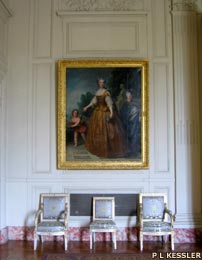 Portrait of Marie Leszczinska in the Chapel Salon of the Grand Trianon | |
| | Meanwhile, the little village of Versailles had prospered and grown into a small city in line with the massive works on the palace. While at its peak before the Revolution, the city would have a population of more than 50,000, even at the start of the eighteenth century it could boast around 20,000 inhabitants. Eventually, something in the region of 36,000 workmen were employed on the various stages of construction on the palace, and the city enjoyed the benefits. End of the 'Sun King' By 1710 Louis was seventy-two, and one major feature remained to be added to the palace which had been his full-time home for twenty-eight years. The Chapel Royal was completed and consecrated in 1710 under the direction of Robert de Cotte, after Jules Hardouin-Mansart died at Marly in 1708. De Cotte (1656-1735) was Mansart's brother-in-law, and he succeeded him as the king's architect from 1708 to 1735. A mixture of Gothic and Baroque styles, the chapel's height resembled a medieval cathedral while its columns and balustrades were very typical of the early 1700s. The chapel was consecrated to St Louis (King Louis IX, the Crusader king) and is considered to be one of the palace's highlights. No more construction work was to be undertaken at the palace for around twenty years, and the king's last years were not entirely happy ones. His son, the dauphin (the heir to the throne), died in 1711. His grandson, Louis, duke of Burgundy, became the dauphin, but he only survived his father by a year. His wife, the by-now twenty-six year-old Marie-Adelaide, contracted measles and Louis refused to leave her bedside. As a result he also contracted the disease and the couple died within a week of each other. His death precipitated a minor crisis in the succession, as his son, another Louis who was aged just five, also died of measles less than a month later. His younger brother became dauphin and Louis XIV, realising his own days were limited, organised a regency to govern the country until the child reached his majority. | | | |
| | Louis XIV died in 1715, shortly before his seventy-seventh birthday. He left the throne to that five year-old great-grandson, Louis, duke of Anjou, who was now Louis XV. Louis XV When Louis XV returned to his childhood home in 1722, a certain amount of work had already been undertaken to complete the Hercules Salon in 1710-1714, which had lain unfinished since the death of the old king. This included removing the older decor and adding new ornamentation, but there was more to follow, as the new king sought a level of privacy in his home. Adjacent to the King's Chamber and opening into the Hall of Mirrors, the Council Study took its final form in 1755, when it was created by combining two rooms together: the 'King's Study', where Louis XIV had held his ministerial councils for financial and state matters, and the Terms Study, which was a more intimate room to which the king retired with his family or inner circle in the evenings for supper. Various apartments for the royal family were also completed within the chateau. The work was overseen by the architect Ange-Jacques Gabriel (1698-1782), with sumptuous wood panelling carved by Antoine Rousseau from Gabriel's drawings. Gabriel was born in Paris in 1698 and had been partially trained by his father. He succeeded his father as Premier Architect at Versailles in 1742, after working as his assistant for seven years. The gardens were left much as they were, but Louis left the Grand Trianon to his wife, Marie Leszczinska and her father Stanislas, former king of Poland during the Polish War of Succession in 1733. But in 1750 his interest in the Grand Trianon was renewed and the building was redecorated. The Petit Trianon was constructed in 1761, under the direction of Louis and with Gabriel's assistance. This was his best-known work; a Neoclassical structure with a squarish plan and double-height Corinthian columns. It was designed for Madame de Pompadour, the king's beloved mistress (Jeanne-Antoinette Poisson, eleven years the king's junior and his close confidant in her later years), but unfortunately she died just three years later. | |
Portrait of Marie Leszczinska in the Chapel Salon of the Grand Trianon | |
| | Meanwhile, the little village of Versailles had prospered and grown into a small city in line with the massive works on the palace. While at its peak before the Revolution, the city would have a population of more than 50,000, even at the start of the eighteenth century it could boast around 20,000 inhabitants. Eventually, something in the region of 36,000 workmen were employed on the various stages of construction on the palace, and the city enjoyed the benefits. End of the 'Sun King' By 1710 Louis was seventy-two, and one major feature remained to be added to the palace which had been his full-time home for twenty-eight years. The Chapel Royal was completed and consecrated in 1710 under the direction of Robert de Cotte, after Jules Hardouin-Mansart died at Marly in 1708. De Cotte (1656-1735) was Mansart's brother-in-law, and he succeeded him as the king's architect from 1708 to 1735. A mixture of Gothic and Baroque styles, the chapel's height resembled a medieval cathedral while its columns and balustrades were very typical of the early 1700s. The chapel was consecrated to St Louis (King Louis IX, the Crusader king) and is considered to be one of the palace's highlights. No more construction work was to be undertaken at the palace for around twenty years, and the king's last years were not entirely happy ones. His son, the dauphin (the heir to the throne), died in 1711. His grandson, Louis, duke of Burgundy, became the dauphin, but he only survived his father by a year. His wife, the by-now twenty-six year-old Marie-Adelaide, contracted measles and Louis refused to leave her bedside. As a result he also contracted the disease and the couple died within a week of each other. His death precipitated a minor crisis in the succession, as his son, another Louis who was aged just five, also died of measles less than a month later. His younger brother became dauphin and Louis XIV, realising his own days were limited, organised a regency to govern the country until the child reached his majority. | | | |
| | Louis XIV died in 1715, shortly before his seventy-seventh birthday. He left the throne to that five year-old great-grandson, Louis, duke of Anjou, who was now Louis XV. Louis XV When Louis XV returned to his childhood home in 1722, a certain amount of work had already been undertaken to complete the Hercules Salon in 1710-1714, which had lain unfinished since the death of the old king. This included removing the older decor and adding new ornamentation, but there was more to follow, as the new king sought a level of privacy in his home. Adjacent to the King's Chamber and opening into the Hall of Mirrors, the Council Study took its final form in 1755, when it was created by combining two rooms together: the 'King's Study', where Louis XIV had held his ministerial councils for financial and state matters, and the Terms Study, which was a more intimate room to which the king retired with his family or inner circle in the evenings for supper. Various apartments for the royal family were also completed within the chateau. The work was overseen by the architect Ange-Jacques Gabriel (1698-1782), with sumptuous wood panelling carved by Antoine Rousseau from Gabriel's drawings. Gabriel was born in Paris in 1698 and had been partially trained by his father. He succeeded his father as Premier Architect at Versailles in 1742, after working as his assistant for seven years. The gardens were left much as they were, but Louis left the Grand Trianon to his wife, Marie Leszczinska and her father Stanislas, former king of Poland during the Polish War of Succession in 1733. But in 1750 his interest in the Grand Trianon was renewed and the building was redecorated. The Petit Trianon was constructed in 1761, under the direction of Louis and with Gabriel's assistance. This was his best-known work; a Neoclassical structure with a squarish plan and double-height Corinthian columns. It was designed for Madame de Pompadour, the king's beloved mistress (Jeanne-Antoinette Poisson, eleven years the king's junior and his close confidant in her later years), but unfortunately she died just three years later. | | 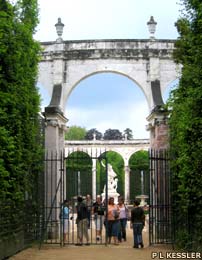 The high-gated entrance to the Colonnade Grove | |
| | In the city of Versailles, the strict rules on building which had been in place under Louis XIV were abandoned under his successor, which lead to speculative building and plots exchanging hands for greatly inflated sums. More minor work continued on the palace itself and on the grounds in the 1760s and 1770s. It continued right up to 1774 when Louis XV died at the age of sixty-four, after a reign which had generally been a disappointment to his people owing to a perceived lack of morals, and failings in his foreign policy. Louis XVI Little work of note was completed on the palace during the reign of Louis XVI, except that which is more properly ascribed to his wife, Marie-Antoinette. Much of that work involved remodelling and redecoration instead of construction. The 'Louis XVI' style was developed by Gabriel, the 'Premier Architect', and was one of simple classical ornamentation and gilded panelling. The Petit Trianon was given over to Marie-Antoinette during her time as queen. It was a very private part of the gardens and park in which she could escape. Hills were removed and lakes and streams were created. Overlooking the lake, the Belvedere, a small eight-sided pavilion, was built in 1774-1777. and the Temple of Love was built over the next year on an artificial island. This structure was a shallow cupola supported by twelve tall columns which provided a setting for Bouchardon's statue of the 'God of Love' carving his bow from Hercules' club. Finally, the best-known of Marie-Antoinette's constructions was the Hamlet, which was constructed in 1783-1785. The Hamlet (or Hameau) was a working village in miniature which contained a farm, twelve thatched cottages with gardens, a dovecote, a mill, and a tower from which the whole scene could be viewed. The queen herself would visit, wearing plain white dress and a straw hat. Unfortunately, in pursuing her desire for a private life, Marie-Antoinette spent extravagantly from the royal treasury, stretching an already-fragile budget in difficult financial times and adding to her unpopularity with the public. The public knew nothing of her quest for a private life, preferring to believe outrageous stories of extravagant life at the palace, and this contributed much to her becoming a symbol for the discontent of the population. | |
The high-gated entrance to the Colonnade Grove | |
| | In the city of Versailles, the strict rules on building which had been in place under Louis XIV were abandoned under his successor, which lead to speculative building and plots exchanging hands for greatly inflated sums. More minor work continued on the palace itself and on the grounds in the 1760s and 1770s. It continued right up to 1774 when Louis XV died at the age of sixty-four, after a reign which had generally been a disappointment to his people owing to a perceived lack of morals, and failings in his foreign policy. Louis XVI Little work of note was completed on the palace during the reign of Louis XVI, except that which is more properly ascribed to his wife, Marie-Antoinette. Much of that work involved remodelling and redecoration instead of construction. The 'Louis XVI' style was developed by Gabriel, the 'Premier Architect', and was one of simple classical ornamentation and gilded panelling. The Petit Trianon was given over to Marie-Antoinette during her time as queen. It was a very private part of the gardens and park in which she could escape. Hills were removed and lakes and streams were created. Overlooking the lake, the Belvedere, a small eight-sided pavilion, was built in 1774-1777. and the Temple of Love was built over the next year on an artificial island. This structure was a shallow cupola supported by twelve tall columns which provided a setting for Bouchardon's statue of the 'God of Love' carving his bow from Hercules' club. Finally, the best-known of Marie-Antoinette's constructions was the Hamlet, which was constructed in 1783-1785. The Hamlet (or Hameau) was a working village in miniature which contained a farm, twelve thatched cottages with gardens, a dovecote, a mill, and a tower from which the whole scene could be viewed. The queen herself would visit, wearing plain white dress and a straw hat. Unfortunately, in pursuing her desire for a private life, Marie-Antoinette spent extravagantly from the royal treasury, stretching an already-fragile budget in difficult financial times and adding to her unpopularity with the public. The public knew nothing of her quest for a private life, preferring to believe outrageous stories of extravagant life at the palace, and this contributed much to her becoming a symbol for the discontent of the population. | | 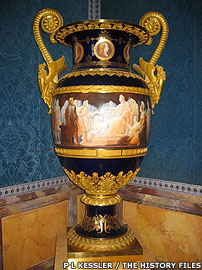 One of many ornaments which decorate the palace | |
| | Louis XVI himself neglected to keep the menagerie fully maintained. Money was in short supply and some people thought it might be wiser to present the menagerie as a site for the study of natural history rather than royal pomp. The count de Buffon, a naturalist, author, cosmologist, mathematician, and biologist, who found the menagerie to be too artificial to be a useful observation post, had warned of exploited animal slaves in his first pages on domestic animals. Subsequently, some restoration work was carried out between 1785-1787. Revolution The palace remained the home of the king until 1790, when the beginnings of the French Revolution were witnessed in the capital - which was still Versailles. A Paris mob invaded the palace on 5-6 October 1789, and Louis and his family were forced to return to Paris. The Revolutionary National Constituent Assembly followed, and Versailles lost its role as the nation's capital. Following on from those dramatic events, the city's population also started to diminish. By 1806 it had sunk below 27,000 people. The furniture was removed from the palace and Grand Trianon during the years of the Terror in 1793-1794. Royal emblems were removed, books and ornaments were stolen, and some areas of the palace were used as an arms dump, while the rest lay abandoned. Following the Revolution, the aging menagerie was included in the list of things to be sold off. In 1797 the palace was designated a museum which would be devoted exclusively to French works. This opened in 1801, only to be taken over by Napoleon Bonaparte shortly afterwards. In 1801, the menagerie was destroyed, with the exception of two of the former duchess of Burgundy's pavilions. Today, the Pavillion de la Lanterne, a hunting lodge and the only surviving vestige of the former menagerie, is being restored to provide visitors with a glimpse of the lively decoration used in this lost masterpiece. Empire and afterwards | |
One of many ornaments which decorate the palace | |
| | Louis XVI himself neglected to keep the menagerie fully maintained. Money was in short supply and some people thought it might be wiser to present the menagerie as a site for the study of natural history rather than royal pomp. The count de Buffon, a naturalist, author, cosmologist, mathematician, and biologist, who found the menagerie to be too artificial to be a useful observation post, had warned of exploited animal slaves in his first pages on domestic animals. Subsequently, some restoration work was carried out between 1785-1787. Revolution The palace remained the home of the king until 1790, when the beginnings of the French Revolution were witnessed in the capital - which was still Versailles. A Paris mob invaded the palace on 5-6 October 1789, and Louis and his family were forced to return to Paris. The Revolutionary National Constituent Assembly followed, and Versailles lost its role as the nation's capital. Following on from those dramatic events, the city's population also started to diminish. By 1806 it had sunk below 27,000 people. The furniture was removed from the palace and Grand Trianon during the years of the Terror in 1793-1794. Royal emblems were removed, books and ornaments were stolen, and some areas of the palace were used as an arms dump, while the rest lay abandoned. Following the Revolution, the aging menagerie was included in the list of things to be sold off. In 1797 the palace was designated a museum which would be devoted exclusively to French works. This opened in 1801, only to be taken over by Napoleon Bonaparte shortly afterwards. In 1801, the menagerie was destroyed, with the exception of two of the former duchess of Burgundy's pavilions. Today, the Pavillion de la Lanterne, a hunting lodge and the only surviving vestige of the former menagerie, is being restored to provide visitors with a glimpse of the lively decoration used in this lost masterpiece. Empire and afterwards | | 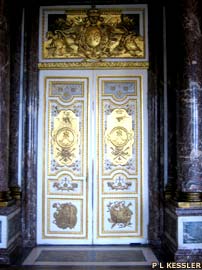 An ornate and gilded doorway within the King's Apartments | |
| | The French 'First Empire' was declared in 1803, and Napoleon Bonaparte had the palace restored and rearranged, with imperial emblems being installed throughout in 1806. The palace also evolved under Napoleon, with work being carried out between 1810-1812. He envisaged moving there, to install himself in the former 'Queen's Suite', while the Empress Marie-Louise, his second wife, would reside on the ground floor. His sister, the playful Pauline, was allocated the Petit Trianon. In the end it seems he may only have visited once. After that the palace was almost totally abandoned for a while. Louis Philippe, the last king of France (1830-1848) rescued it from total ruin by creating a national monument of it in 1833 - the Museum of French History, which was opened in 1837. He often stayed at the Grand Trianon with his family. In 1871, following the Prussian defeat of France in the Franco-Prussian War, King Wilhelm I of Prussia was proclaimed emperor of Germany. The pronouncement took place in the Hall of Mirrors. Just two months later the Paris Commune forced the French authorities to move temporarily to Versailles. The signing of the Treaty of Frankfurt on 10 May 1871 was followed by the creation of a new provisional government headed by President Louis Adolphe Thiers at Versailles. From there the government was able to quell the uprising militarily. Instead of moving directly back to Paris, the government toyed with the idea of remaining permanently located in Versailles to avoid the frequently volatile Paris mob. After remaining there for some time the idea was dropped by the continually successful republicans in 1879, with all popular support for a restoration of the monarchy having been defeated. Seven years of rule from Versailles did leave the palace with one memento: a large hall which was built into an aisle in the main palace and which is still in use today by the French government when amendments to the constitution are planned. The Grand Trianon and the palace were the locations used for the signing of the various treaties which brought an end to the Great War in 1918. The Treaty of Versailles was signed in the Grand Trianon on 28 June 1919. | |
An ornate and gilded doorway within the King's Apartments | |
| | The French 'First Empire' was declared in 1803, and Napoleon Bonaparte had the palace restored and rearranged, with imperial emblems being installed throughout in 1806. The palace also evolved under Napoleon, with work being carried out between 1810-1812. He envisaged moving there, to install himself in the former 'Queen's Suite', while the Empress Marie-Louise, his second wife, would reside on the ground floor. His sister, the playful Pauline, was allocated the Petit Trianon. In the end it seems he may only have visited once. After that the palace was almost totally abandoned for a while. Louis Philippe, the last king of France (1830-1848) rescued it from total ruin by creating a national monument of it in 1833 - the Museum of French History, which was opened in 1837. He often stayed at the Grand Trianon with his family. In 1871, following the Prussian defeat of France in the Franco-Prussian War, King Wilhelm I of Prussia was proclaimed emperor of Germany. The pronouncement took place in the Hall of Mirrors. Just two months later the Paris Commune forced the French authorities to move temporarily to Versailles. The signing of the Treaty of Frankfurt on 10 May 1871 was followed by the creation of a new provisional government headed by President Louis Adolphe Thiers at Versailles. From there the government was able to quell the uprising militarily. Instead of moving directly back to Paris, the government toyed with the idea of remaining permanently located in Versailles to avoid the frequently volatile Paris mob. After remaining there for some time the idea was dropped by the continually successful republicans in 1879, with all popular support for a restoration of the monarchy having been defeated. Seven years of rule from Versailles did leave the palace with one memento: a large hall which was built into an aisle in the main palace and which is still in use today by the French government when amendments to the constitution are planned. The Grand Trianon and the palace were the locations used for the signing of the various treaties which brought an end to the Great War in 1918. The Treaty of Versailles was signed in the Grand Trianon on 28 June 1919. | | 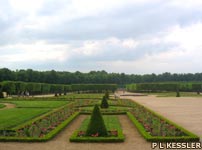 Part of the park behind the Grand Trianon building | |
| | With the population of the city of Versailles now surpassing its previous record levels, important renovations were undertaken in 1957 thanks to a decision by General de Gaulle. The Opera House restoration work was completed in that year, and more was undertaken between 1962-1965 on both the Grand Trianon and in order to install apartments for the president of the republic and for heads of state on official visits. For the most part, the renovations recreated the way the palace had looked under Napoleon I, except for pieces dating from the reign of Louis-Philippe. In 1975 the 'Queen's Bedroom' was restored, followed by the 'King's Ceremonial Bedroom' and the Hall of Mirrors in 1980, the ground floor Royal Apartments in 1986, and in 2008 the Petit Trianon and Maria Antoinette's gardens were fully restored. Today visitor numbers for Versailles are at around 2.58 million a year, making it the fourth most popular cultural attraction in France.
Part of the park behind the Grand Trianon building | |
| | With the population of the city of Versailles now surpassing its previous record levels, important renovations were undertaken in 1957 thanks to a decision by General de Gaulle. The Opera House restoration work was completed in that year, and more was undertaken between 1962-1965 on both the Grand Trianon and in order to install apartments for the president of the republic and for heads of state on official visits. For the most part, the renovations recreated the way the palace had looked under Napoleon I, except for pieces dating from the reign of Louis-Philippe. In 1975 the 'Queen's Bedroom' was restored, followed by the 'King's Ceremonial Bedroom' and the Hall of Mirrors in 1980, the ground floor Royal Apartments in 1986, and in 2008 the Petit Trianon and Maria Antoinette's gardens were fully restored. Today visitor numbers for Versailles are at around 2.58 million a year, making it the fourth most popular cultural attraction in France.  The Apollo Fountain marks the beginning of the Grand Canal | | | |
| | Main Sources Ask Travel for Fun website Bluche, François - Dictionnaire du Grand Siècle, Arthème Fayard, Paris 1991 Établissement public du musée et du domaine national de Versailles Fletcher, Sir Banister - A History of Architecture, Eighteenth Edition, revised by J C Palmes, Charles Scribner's Sons, New York 1975 Galerie Marc Maison website Howe, Professor Jeffery - A Digital Archive of Architecture Mississippi State University - Splendours of Versailles, Educational Supplement, Jackson Mississippi 1998 Palace of Versailles website Salmon, Xavier - François Lemoyne à Versailles, Gourcuff, Paris 2001 Sharp, Dennis - The Illustrated Encyclopaedia of Architects and Architecture, Quatro Publishing, New York 1991 Thompson, Ian - The Sun King's Garden: Louis XIV, André Le Nôtre and the Creation of the Gardens of Versailles, Bloomsbury Publishing, London 2006 Van Vunckt, Randall J, ed - International Dictionary of Architects and Architecture, Volume 2, Architecture, St James Press, Detroit 1993 | | | |
| | | | | |
| | Images and text copyright © P L Kessler. An original feature for the History Files. | | | |
| | | | | |
The Apollo Fountain marks the beginning of the Grand Canal | | | |
| | Main Sources Ask Travel for Fun website Bluche, François - Dictionnaire du Grand Siècle, Arthème Fayard, Paris 1991 Établissement public du musée et du domaine national de Versailles Fletcher, Sir Banister - A History of Architecture, Eighteenth Edition, revised by J C Palmes, Charles Scribner's Sons, New York 1975 Galerie Marc Maison website Howe, Professor Jeffery - A Digital Archive of Architecture Mississippi State University - Splendours of Versailles, Educational Supplement, Jackson Mississippi 1998 Palace of Versailles website Salmon, Xavier - François Lemoyne à Versailles, Gourcuff, Paris 2001 Sharp, Dennis - The Illustrated Encyclopaedia of Architects and Architecture, Quatro Publishing, New York 1991 Thompson, Ian - The Sun King's Garden: Louis XIV, André Le Nôtre and the Creation of the Gardens of Versailles, Bloomsbury Publishing, London 2006 Van Vunckt, Randall J, ed - International Dictionary of Architects and Architecture, Volume 2, Architecture, St James Press, Detroit 1993 | | | |
| | | | | |
| | Images and text copyright © P L Kessler. An original feature for the History Files. | | | |
| | | | | |